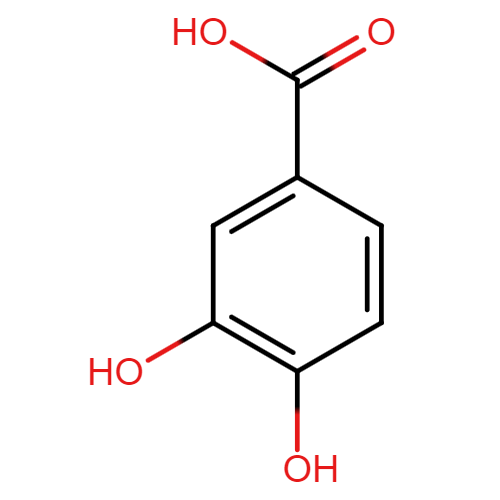3,4-Dihydroxybenzoic acid
| Compound Structure: |

|
||||||||||||||||||||||||||||||||||||||||||||||
|---|---|---|---|---|---|---|---|---|---|---|---|---|---|---|---|---|---|---|---|---|---|---|---|---|---|---|---|---|---|---|---|---|---|---|---|---|---|---|---|---|---|---|---|---|---|---|---|
| Synonyms: | 3,4-DIHYDROXYBENZOIC ACID;protocatechuic acid;99-50-3;Protocatehuic acid;4-Carboxy-1,2-dihydroxybenzene;protocatechuate;4,5-Dihydroxybenzoic acid;Benzoic acid, 3,4-dihydroxy-;3,4-dihydroxybenzoate;protocatechuicacid;b-resorcylic acid;4fht;Protacatechuic A | ||||||||||||||||||||||||||||||||||||||||||||||
| Compound ID: | NMPC-309 | ||||||||||||||||||||||||||||||||||||||||||||||
| PubChem ID: | |||||||||||||||||||||||||||||||||||||||||||||||
| Molecular Formula: | C7H6O4 | ||||||||||||||||||||||||||||||||||||||||||||||
| Canonical SMILES: | C1=CC(=C(C=C1C(=O)O)O)O | ||||||||||||||||||||||||||||||||||||||||||||||
| InChIKey: | YQUVCSBJEUQKSH-UHFFFAOYSA-N | ||||||||||||||||||||||||||||||||||||||||||||||
| About the compound: | 3,4-Dihydroxybenzoic acid, also known as protocatechuic acid (PCA), is a dihydroxybenzoic acid with hydroxy groups at positions 3 and 4 on the benzene ring. It is naturally found in various organisms and has drawn scientific interest due to its potential health benefits and biological activities: Protocatechuic acid is known for its antioxidant and anti-inflammatory properties. It has been shown to protect against chemically induced liver toxicity in vivo (in living organisms). In vitro tests have confirmed its antioxidant and anti-inflammatory activities. PCA has exhibited various effects on cancer cells. It has been reported to induce apoptosis (programmed cell death) in human leukemia cells and malignant cells from human oral cavities. However, its effects on skin tumors appear to be mixed, as it can either reduce or enhance tumor growth depending on the concentration and timing of application. Protocatechuic acid has demonstrated antiviral activity by effectively inhibiting the replication of herpes simplex virus type 2. It has also been found to deactivate the catalytic activity of urease, an enzyme produced by some bacteria. PCA can be isolated from various plant sources, including the stem bark of Boswellia dalzielii and leaves of Diospyros melanoxylon. In the context of insects, protocatechuic acid is involved in the hardening of the protein component of insect cuticle (exoskeleton). It plays a role in tanning, which is the process that strengthens and hardens the cuticle. The diverse range of activities associated with protocatechuic acid makes it a subject of interest in fields such as medicine, nutrition, and agriculture. Researchers continue to study its potential applications and mechanisms of action. GHS Hazard Statements • H315 (75.96%): Causes skin irritation [Warning Skin corrosion/irritation] • H319 (75.96%): Causes serious eye irritation [Warning Serious eye damage/eye irritation] • H335 (95.08%): May cause respiratory irritation [Warning Specific target organ toxicity, single exposure; Respiratory tract irritation] • H411 (24.04%): Toxic to aquatic life with long lasting effects [Hazardous to the aquatic environment, long-term hazard] |
||||||||||||||||||||||||||||||||||||||||||||||
| Properties: |
Chemical
and Physical Properties
Source: PubChem |
||||||||||||||||||||||||||||||||||||||||||||||
| Source Species: |
Deinbollia pinnata Musanga cecropioides Ficus thonningii |